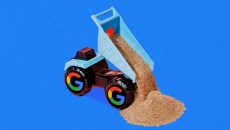At industry conference, Google tries to salvage the Privacy sandbox after U-turn on third-party cookies

Digiday is at Possible giving you the latest industry news out of the event in Miami. More from the series →
Google isn’t known for saying sorry so the fact that it’s offering something close to a mea culpa at an industry conference in Miami says a lot about the chaos its Chrome cookie plan has unleashed.
Last week, the company announced that it would continue to permit third-party cookies in its web browser Chrome, upending nearly six years of planning for many.
Despite its careful messaging, the move effectively marks the putative death of the accompanying Privacy Sandbox experimentations, and this week, Google set out on what many expected to be a (much-called-for) apology tour at the Possible conference.
“Mostly everyone is just complaining about what a giant waste of time, energy and manpower Google put us through… It’s almost like they did it to distract us all from actually innovating,” one anonymous publisher-side source said, before much of the industry decamped to the four-day conference in Miami.
Resetting expectations
However, separate sources who spoke directly with Google noted how Privacy Sandbox representatives framed the shift, announced April 22, as a relief for the team. This is because, when third-party cookie deprecation was initially announced in 2020, Google’s task became solving every ad tech challenge that followed — a burden that hindered product quality.
According to such sources, with expectations reset, the Privacy Sandbox team can now focus on building strong browser-level privacy features without replacing everything cookies once did.
Joe Root, CEO and co-founder of Permutive, noted how Google had previously set hard deadlines, which placed significant pressure on itself. In its initial January 2020 messaging, Google claimed third-party cookie deprecation would happen in 2022, only to postpone on several occasions, thus further stiffening its task.
“There’s been relatively little browser innovation, which hasn’t happened in a pressure cooker,” he said. “Now we don’t have this looming, I’m actually quite excited about the ability for us to work with Google to see if we can make browser functionality better?”
These meetings in Miami this week echo the ones Google execs have been holding since last week’s reversal. Apologies aside, they’ve been eager to reassure the industry that the Sandbox is still moving forward.
The assurances aren’t landing
But so far, many of those reassurances haven’t landed. Yes, the future of third-party cookies in Chrome is finally clear — they’re staying. However, Google’s Sandbox replacement plan remains anything but. The company insists it’s the way forward, but the industry isn’t 100% convinced.
Then again, it never really was. For the past five years, these cookie alternatives, contained in Google’s Privacy Sandbox, have been entangled in technical flaws and ideological disputes that have kept consensus — and confidence — out of reach.
Even so, ad tech vendors — the ones expected to do the heavy lifting — never fully checked out. Few were building in earnest, but some were testing, asking questions and trying to stay on Google’s good side — just in case third-party cookies really did go away. Now that cookies are staying, so is the skepticism. Google’s abrupt U-turn evaporated whatever thin enthusiasm the Sandbox had left.
“We hit the pause button on the Sandbox 12 months ago, and it’s hard to see how we reverse that decision now,” said a senior ad tech exec, who was granted anonymity to speak freely.
Meanwhile, a separate source, with experience testing Privacy Sandbox proposals and assisting the U.K. competition regulator in overseeing the Google-led initiative, told Digiday that a lack of clarity on its outcomes meant enthusiasm wavered over time.
“It just kind of fizzled out,” said the source, who requested anonymity to maintain relationships. “We looked at the signals we were seeing from Sandbox and put them into our models to see if it improved campaign performance, but there just wasn’t enough to warrant implementing it fully.”
Vague answers
For ad tech vendors — and many others — the risk of diving back into the Privacy Sandbox feels higher than ever, and the reward is harder to imagine. Nothing Google’s executives said after the reversal helped ease those doubts. If anything, they only made the doubts run deeper. Some walked away from those meetings with even more questions than they came in with.
There were the usual vague responses to familiar questions — like what’s the real incentive to build toward a future that may never arrive? — along with a fresh batch prompted by Google’s change of heart.
For instance, Google said it would share an “updated roadmap for these technologies, including our future areas of investment, in the coming months.” But when ad tech execs floated suggestions — like optimizing cookie-less retargeting on cost-per-click instead of just cost-per-thousand — Google’s execs didn’t exactly sound open to them. Nor were they particularly forthcoming when pressed for examples of privacy-enhancing technologies being widely adopted — something Anthony Chavez, vp of Privacy Sandbox, cited as one of the reasons the sandbox will continue, albeit with changes.
“You know how these calls go — they didn’t share much,” said a separate anonymous ad tech exec.
Few plan a return to the Sandbox
That sentiment was echoed again and again in conversations Digiday had with multiple ad execs in the week since the change.
Permutive’s Root further discussed the overwhelming consumer choice to opt out of cookies, noting how forward-thinking publishers have shifted their strategies toward direct sales and curation to mitigate the impact of cookie deprecation from the beginning of the 2020s.
Jana Meron, an executive with extensive in-house experience helping publishers employ ad tech to improve yield at titles such as Business Insider and The Washington Post, told Digiday the importance of first-party data collection and organization has never been clearer.
“I don’t know why anyone would [focus on Privacy Sandbox] again,” she added. “Frankly, I don’t know how many publishers were investing all that much time and effort into it after the last pause.”
Meron, who now consults with publishers via her Lioness Strategies outfit, went on to raise the question of how much of Google’s decision-making on the long-term fate of third-party cookies is likely influenced by its ongoing battles with the U.S. Justice Department.
In the meantime, publishers should focus on what they can control: assembling their core first-party data assets and ensuring they are interoperable with what buyers are in market for. “This is all about the data and where it gets stored … if the cookie stores a bunch of information, and they’re interoperable, then it doesn’t matter,” she added.
Even the few still clinging to the Sandbox speak about it like it’s a mirage on the horizon.
“I don’t think we know right now,” one commercial exec said when asked to elaborate on their commitment to the Sandbox — a line delivered after multiple conversations with Google since the announcement. Sticking with the plan no longer requires knowing what the plan is.
“We may, like almost everyone else, stick with Topics depending on the coverage there,” said another ad tech exec. “We’re definitely skipping PAAPI now. I kinda hope it dies.”
The visceral frustration is understandable. Committing to the Sandbox isn’t just a strategic risk — it’s a costly one. According to an ad tech exec who’s actually costed it, building for it would require up to 8,000 days of work over the next three years for many ad tech companies. At $800 a day, that’s roughly $6.4 million — without even factoring in the extra maintenance, support and consulting costs needed to get a product of that scale into the market.
Ultimately, it’s just the latest variation on a familiar theme: the slow, grinding malaise that has dogged the Sandbox for the past five years. Much comes down to structural problems baked into Google’s alternatives to third-party cookies.
For one, Google needs to open what Chrome calls the “top-level seller,” currently reserved for the Google Ad Manager ad server. Without that, publishers and advertisers get no API data on how audience segments are being targeted. Then there’s latency. Traditionally, cloud infrastructure and sprawling server farms handle the immense bandwidth needed to process billions of ad impressions in milliseconds, notifying countless servers and vendors. With the Sandbox, much of that work gets offloaded to individual devices — a shift that risks creating major bottlenecks at scale.
More in Marketing

In Graphic Detail: Why YouTube is a genuine threat to Netflix
Digiday has charted exactly how YouTube is a real threat to Netflix, due to its dominance of watch time, user base and its ability to totally reshape viewing behaviors.

At Ebiquity, a new role signals marketing’s shift from metrics to meaning
Marketing has no shortage of data. Ebiquity is betting on judgement.

Lowe’s wants to do more with AI shopping in 2026
Mylow, a shopping assistant powered by ChatGPT that launched in March, is already driving double the conversion rate for online shoppers.











